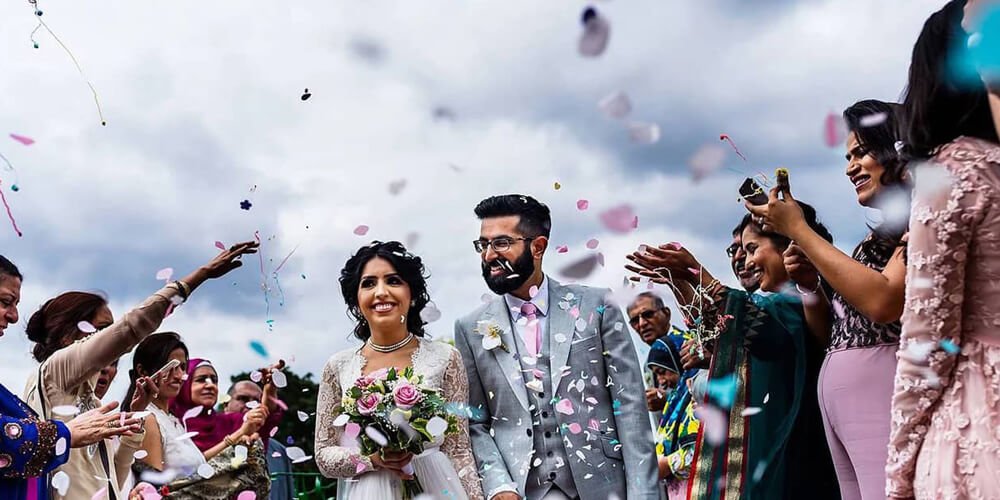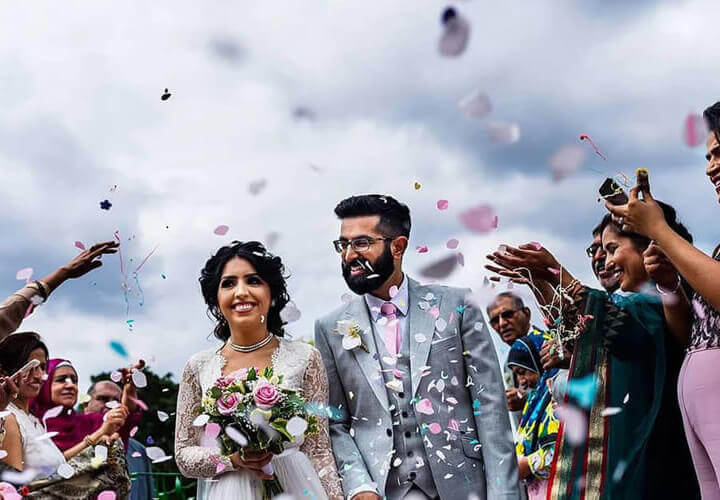Indian Wedding

Indian Wedding

What happens on a Traditional Hindu Wedding
Indian weddings involve a lot of tradition and rituals. Each year we do more than ten large scale Indian weddings. We know that it is not only about the birde and groom, but also about the unification of two families. Thus we understand the you will be judged by the venue you choose, by the dinner menu you choose and finally the wedding planner you work with. Dubai Wedding Team represents the highest level and we never take compromises on quality. We understand that Indian weddings need to be lavish but at the same time well budget-ed. If you decide to work with us, then we will assist you with everything from negotiating the prices to creating a custom mendap decoration or even sourcing the alcoholic beverages.
Hindu Indian wedding involve a lot of tradition but no all of them follow the same strict. Couples will choose different traditions to follow depending on the region they are coming from. We have a deep understanding on the rituals and preferences of indian families when it comes to a wedding. In this section we will uncover the importance of Mendap, Mehendi, Haldi, Baraat, Kanyadaan, the Seven sacred Vows, Sari.
Ashramas: Stages Of Life
Marriage is a very solemn commitment in Hinduism. The Vedas is to Hinduism what the Bible is to Christianity. These sacred scriptures divide life into four stages called ashramas. These are studentship, householder, retirement, and self-realization. Marriage represents moving from studentship to householder. As such Hindus hold marriage in high regard. After all, they build three-quarters of their life stages on it. Because of this importance, the Hindu wedding ceremony has many rituals and traditions. So much so that a true Hindu wedding can last for several days. Life is much more fast-paced than it used to be. Modern couples tend to pare it down to two to three days only.
Mendap
2. It’s important to note that Hindu ceremonies are not only about the bride and groom. Their marriage is joining two families together. The Hindu wedding ceremony itself takes place under a canopy known as the Mandap. The four poles of the canopy represent each parent of the bride and groom. Hindu tradition dictates that weddings happen outdoors. If that is not possible, they still construct a Mandap indoors. It has great symbolic significance for the ceremony and serves an important purpose.
Mehendi (Henna)
3. Mehendi, or henna as we know it in the West, is important in the Hindu wedding ceremony. Where the bride’s body is a canvas. Her close female friends and family paint intricate designs on her body for the ceremony. Why and what the tradition represents? The bride, the female family and her close friends gather the night before or the morning to decorate the bride. They say that the depth of the henna’s color represents the depth of the couple’s love. A deeper color also means a better relationship with her new mother-in-law. To that end, brides let the henna dry as long as possible, often up to eight hours. Often they will hide the names of the bride and groom within the artwork.
Haldi: A Colorful Affair
4. The purpose of the Haldi ceremony is to ward off evil and bless the couple. It consists of music, dancing, food, and colorful paste.
What’s the paste for? Flinging at each other of course! As you can imagine, you can get some pretty neat photos from a Haldi ceremony.
The idea of the Haldi is solemn. But with the elements we’ve mentioned, it becomes a joyful time full of laughter and rejoicing.
Both the bride and the groom will host separate ceremonies at their respective homes. Only family and intimate friends attend the Haldi.
Invoking Lord Ganesha
5. You have probably seen photos or statues of the Hindu god with the giant elephant head. This is Lord Ganesha. He is the Hindu god of wisdom and salvation. The figure of Ganesha represents a few things to Hindus. The upraised hand signifies protection. The belly signifies generosity and acceptance. The part of particular importance to the Hindu wedding ceremony is the elephant head. It is not common for obstacles to bother elephants. They either remove or trample them and go on about their business. Couples and their families ask Lord Ganesha to remove any obstacles to their wedding.
Arrival of the Groom and His Party – Baraat
6. The arrival of the groom and his party to the Mandap (the canopy) is a joyful affair, an event of its own, it is called the Baraat. Everyone is singing and dancing and the bride’s parents have gifts for them. There are three typical gifts. Rice (akshat), a dot on the forehead (tilak), a plate with a lighted lamp (arati), and a garland.
Blessing of the Planets
7. On occasion, a Hindu wedding ceremony will include a peace with the planets ceremony. They call this the Grahashanti. Each planet offers a special blessing to the couple for their new life together.
Offering the Bride
8. The ritual for offering the bride is more in-depth than what you would see at a typical Western wedding.
Binding Two People Together
9. The purpose of the next ritual is to symbolize the unbreakable bond of marriage. The groom takes the right hand of the bride with his right hand.
Their hands are then tied together by wrapping a cotton thread around them several times. The priest recites holy verses over the couple while this is happening.
The Hindu Wedding Ceremony – Fire Ceremony
10. After all this, we finally get to the core of the Hindu wedding ceremony itself.
Fire is an important part of the ceremony. It represents the Hindu god Agni, who is the sustainer of life in Hindu thought. Using fire as part of a Hindu wedding ceremony represents giving life to the marriage.
Couples can choose to do this part of the ceremony a few different ways. The fire is lit and the couple approaches. Sometimes they may sit in front of it while the priest recites from the scriptures.
Circling the Fire
11. Once the couple finishes with the offerings, they walk around the fire together.
As they are circling, family members and guests will toss the petals on the couple. The purpose is to symbolize showering them with blessings and love.
The number of times they circle depends on the tradition the couple chooses.
12. Sometimes they will walk around four times. This is to symbolize the four stages of life that we mentioned earlier. In some ceremonies, the four circles represent four life goals. Morality, personal gratification, prosperity, and spirituality. As they walk they will also pray and make vows. These are typical vows of love, respect, and fidelity. Other times, the couple will walk around the fire seven times. As with the four circle version, they make vows to each other during the walk.
The Seven Sacred Vows
13. Once the couple completes the walks around the fire, an important Hindu ritual is next. The Seven Sacred Vows are the most ancient of Hindu wedding rituals. They are also what seals the deal. They do not consider the marriage valid until this ceremony is complete. They speak these vows in Sanskrit. This is to lend significance and respect to these words. The groom will assist the bride in taking seven steps. As she walks she pushes a stone with her left foot along the floor. At each step, they make one of the seven vows.
The vows are:
To have mutual honor and respect
To share with one another in both joy and sorrow
To build mutual trust and be loyal to one another
To nurture and appreciate knowledge, service, sacrifice, and values
To appreciate purity in family duties, spiritual growth, emotions, and love
To follow the principles of morality
To nurture an eternal bond based on friendship and love
This is the most important part of the ceremony. Once the couple makes these vows, the Hindu wedding ceremony is complete.
There are still more traditions observed after this, but this is the official part. The community now views the couple as married from this point forward.
The Reception
14. The party afterward tends to look a lot more like a typical Western wedding. You can expect music and dancing and a lavish buffet with live stations and pass-arounds the whole night. You can also expect to see rice, yogurt, salad, and a traditional Indian flatbread called naan. If you’ve never had Indian food before, you’re in for a treat. During the dancing, folks will gather around to toss money at the couple. This is to bless the new couple with prosperity.
Also, a group of dancers may perform a traditional dance for the couple and their guests to enjoy.
Bridal Wear
15. The bridal party is being incorporated more and more in Hindu weddings. But instead of tacky bridesmaid dresses, the bride’s friends wear bright, matching saris. The bride herself wears an elaborate sari. The color can vary depending on what part of India she is from. Red is the most traditional color, symbolizing happiness and good luck. White is the color used for mourning in Hindu culture so they avoid it at weddings. In addition to her henna tattoos, the bride will use lots of heavy gold jewelry. In a traditional Hindu wedding ceremony guests also dress in bright colored saris. As you can imagine the event is very colorful.
Dubai Wedding Services
What happens on a Traditional Hindu Wedding
Indian weddings involve a lot of tradition and rituals. Each year we do more than ten large scale Indian weddings. We know that it is not only about the birde and groom, but also about the unification of two families. Thus we understand the you will be judged by the venue you choose, by the dinner menu you choose and finally the wedding planner you work with. Dubai Wedding Team represents the highest level and we never take compromises on quality. We understand that Indian weddings need to be lavish but at the same time well budget-ed. If you decide to work with us, then we will assist you with everything from negotiating the prices to creating a custom mendap decoration or even sourcing the alcoholic beverages.
Hindu Indian wedding involve a lot of tradition but no all of them follow the same strict. Couples will choose different traditions to follow depending on the region they are coming from. We have a deep understanding on the rituals and preferences of indian families when it comes to a wedding. In this section we will uncover the importance of Mendap, Mehendi, Haldi, Baraat, Kanyadaan, the Seven sacred Vows, Sari.